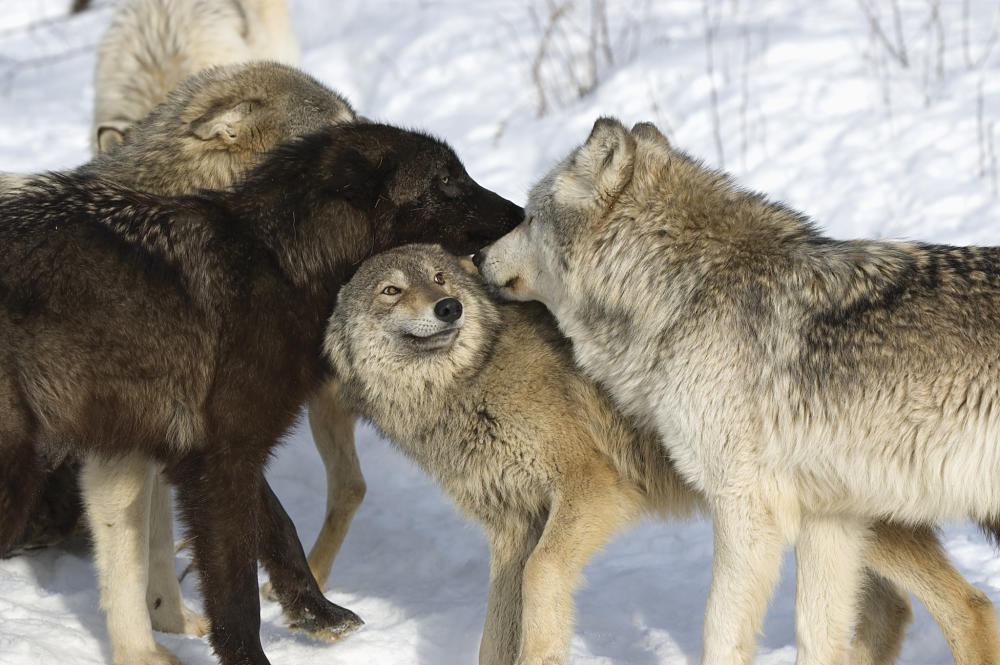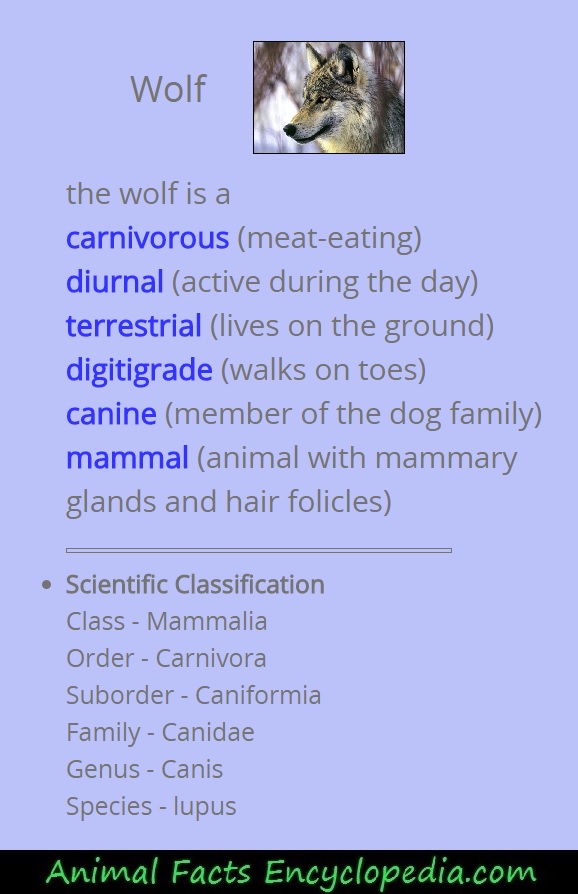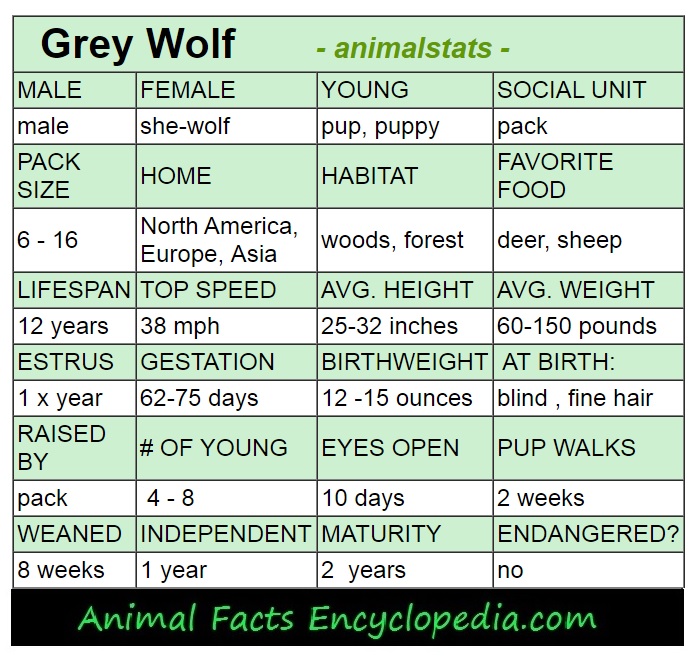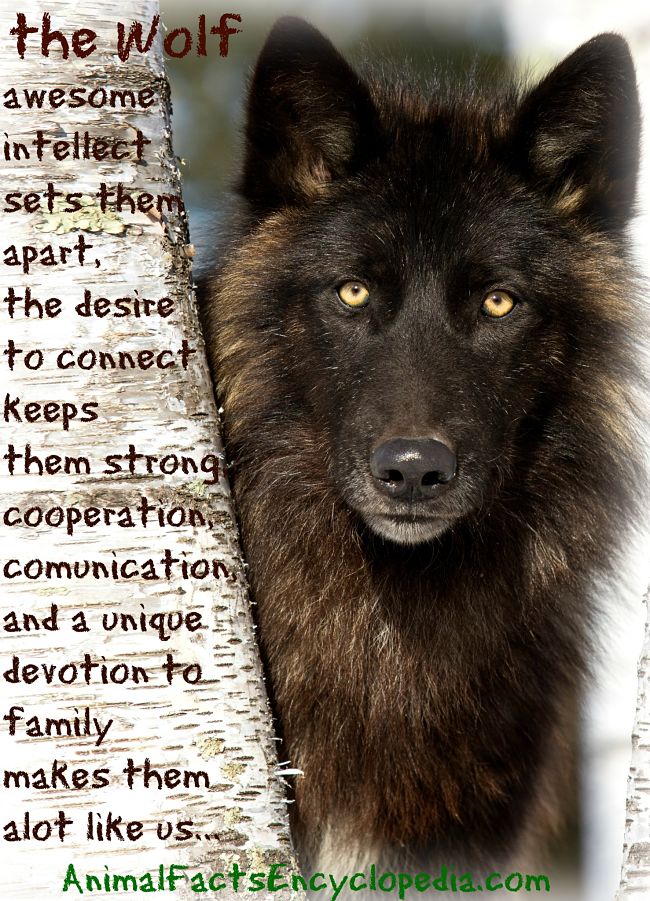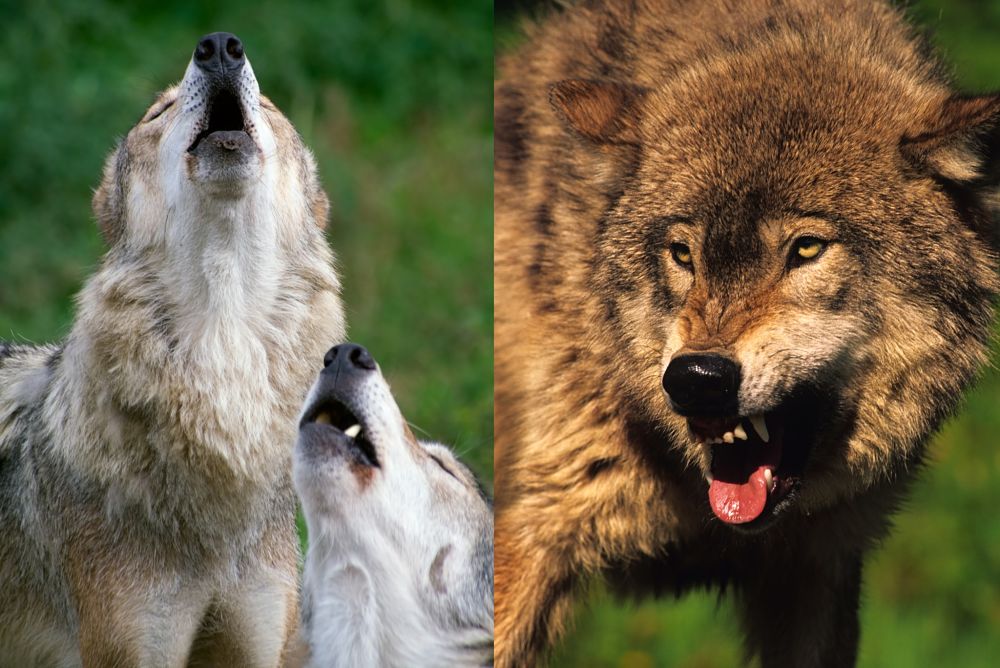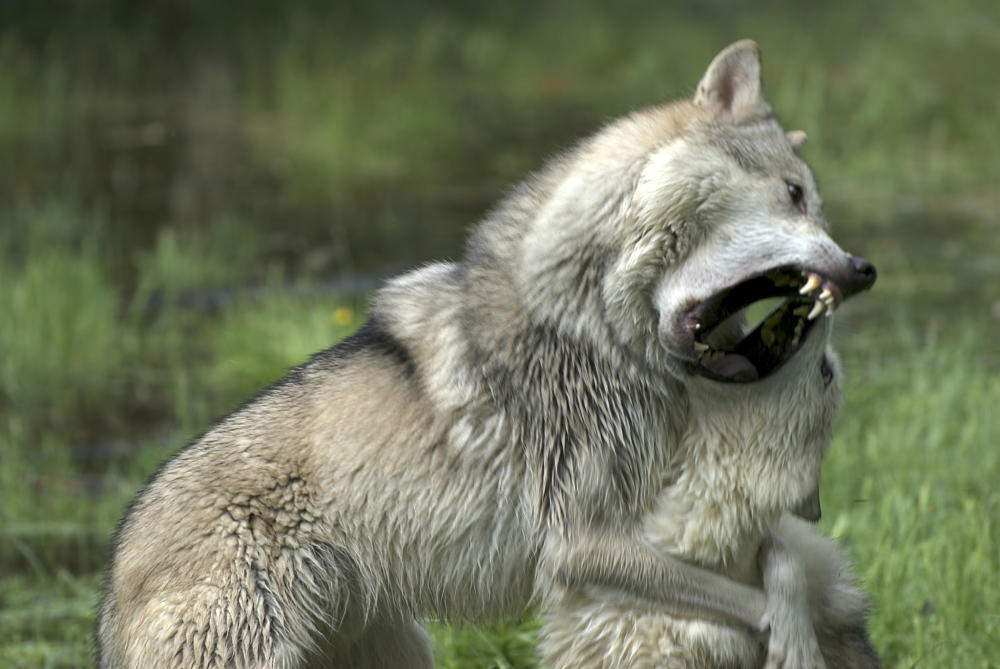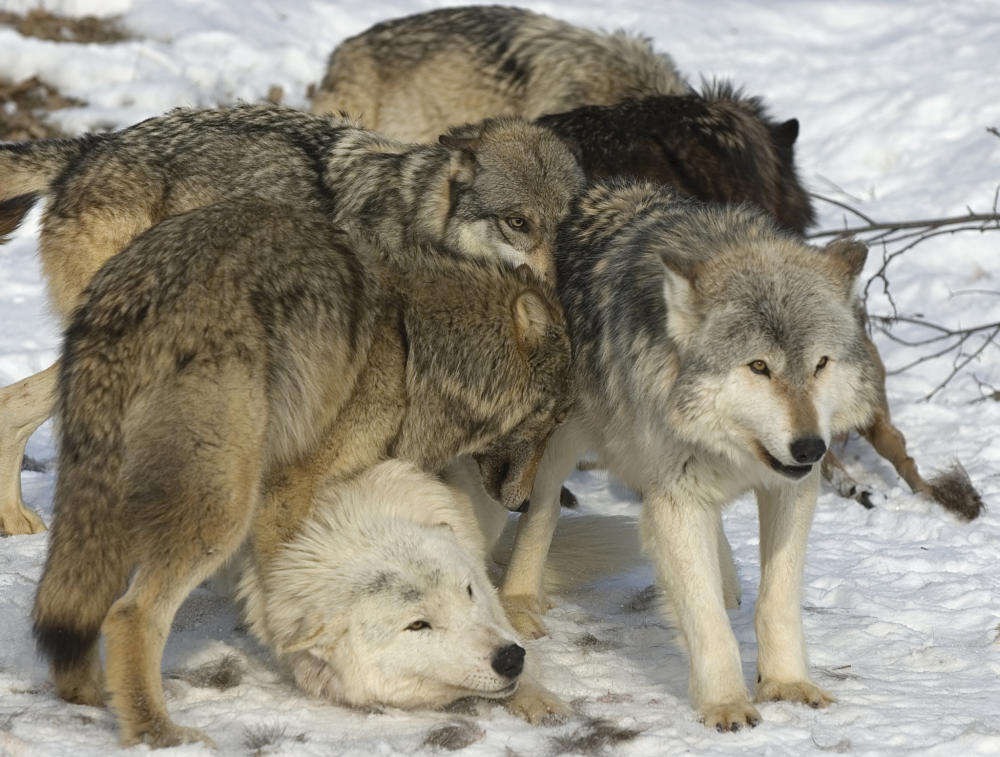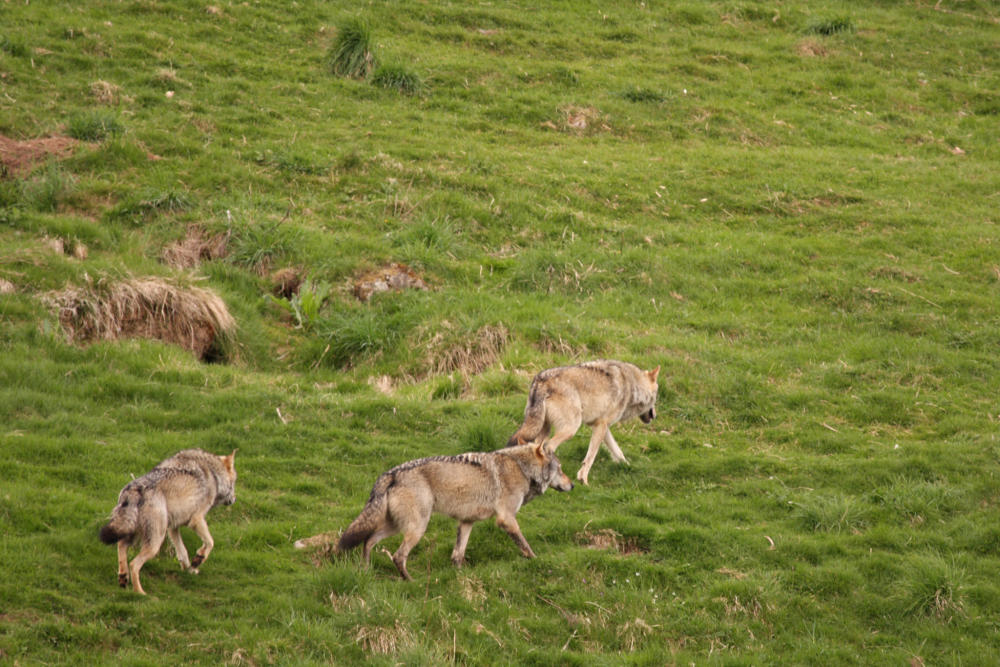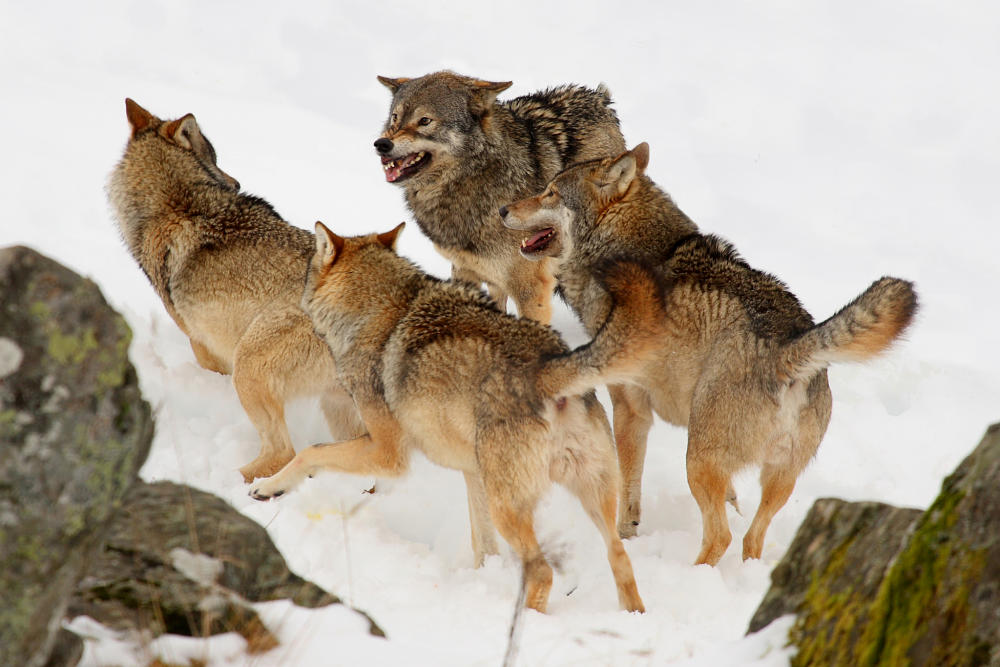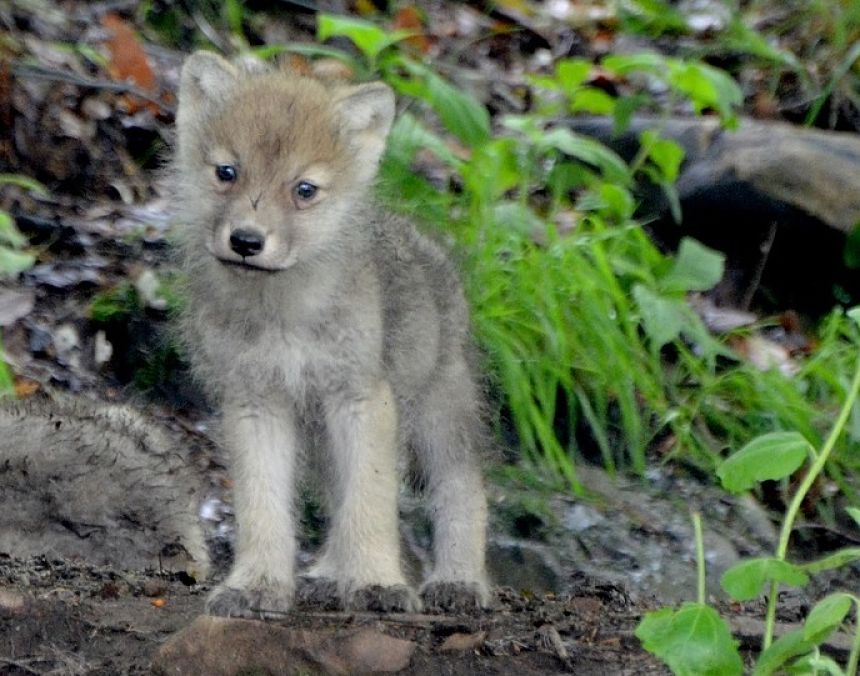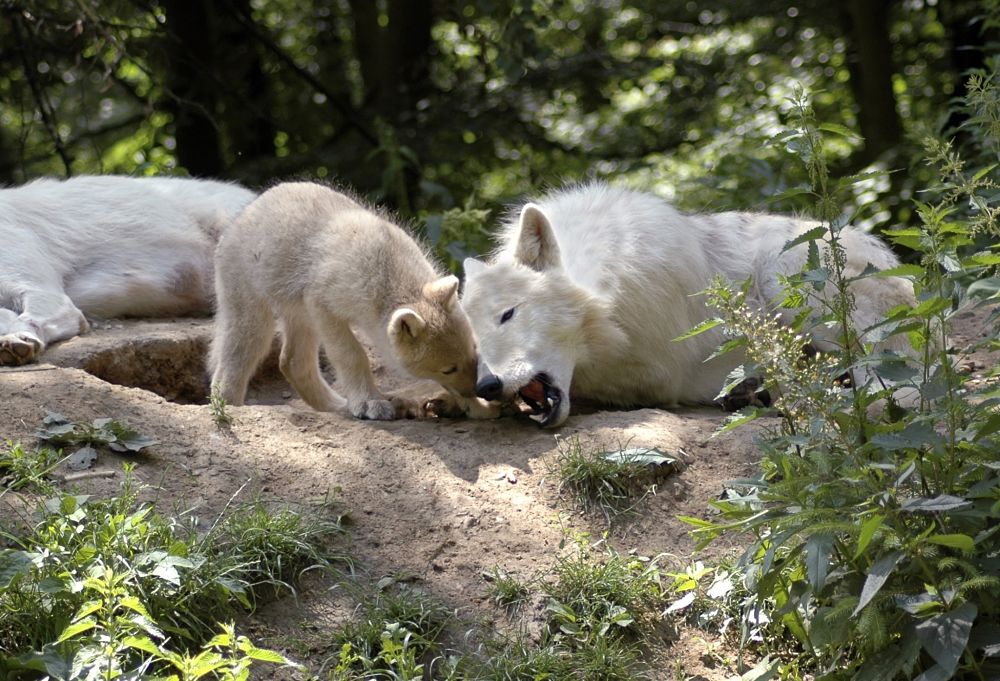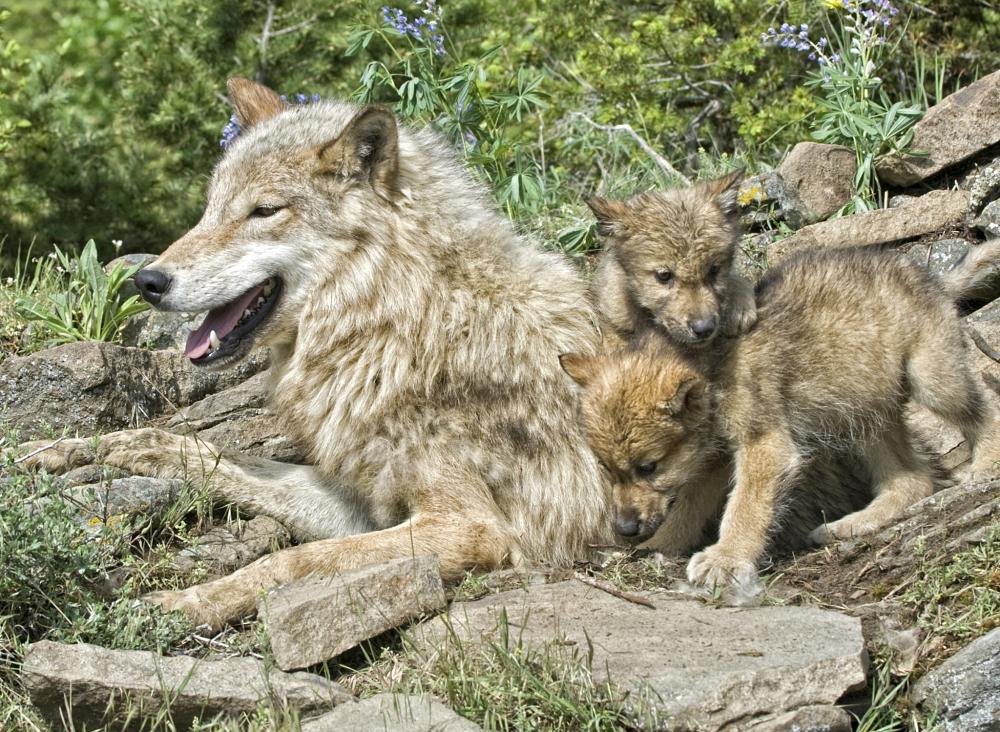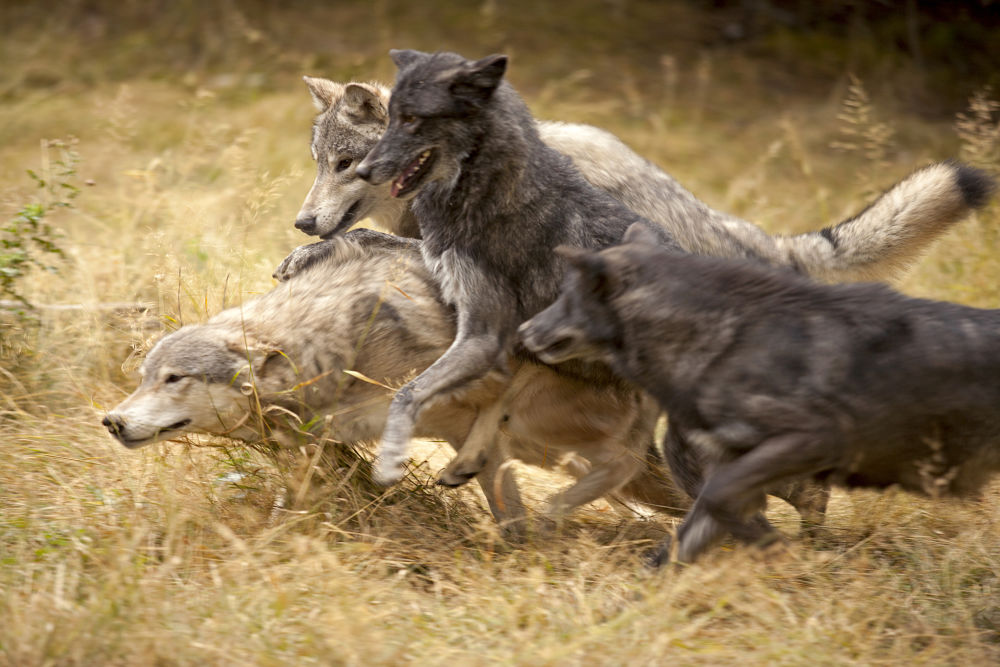Wolf Facts
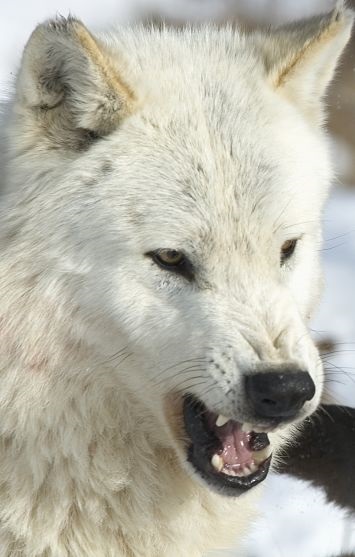 Portrait of a Wolf
Portrait of a Wolf
One of the least known wolf facts is that wolf pups are born with blue eyes. The wolf is the largest species in the dog or canid family. There are two species of wolf, the grey wolf which is found throughout the northern hemisphere, and the red wolf, which is limited to a tiny population in the state of North Carolina.
There are several subspecies of grey wolf in North America, and another 7 to 12 subspecies found in Europe and Asia. These subspecies vary only slightly in size and color, mostly as a result of the variations in climate, habitat and diet in the different locations they occur.
Wolves live in forest and mountain areas where large game animals like goat, deer and moose can be found. Many live in cold climates, and today, the largest numbers can be found in arctic regions, as the habitats in the south slowly disappear.
The Great Plains wolf, Mexican wolf, Arctic wolf, Rocky Mountain wolf and the Eastern timber wolf, (which some consider a separate species) are currently all considered subspecies of the grey wolf. Some of the largest individuals can be found in Alaska, including the largest on record, a huge male weighing 175 pounds.
Most grey wolves average between 70 and 100 pounds, 28 to 34 inches at the shoulder, with males averaging a bit bigger than females.
The domestic dog was once also classified as a subspecies of grey wolf, but recent DNA research shows that dogs and wolves have been evolving separately for more than 30,000 years. The ancestor of both the grey wolf and the dog was a small Eurasian wolf weighing less than 40 pounds, which has been extinct for nearly 15,000 years.
But wolves and dogs still carry many of the traits of that animal, such as an extremely cooperative personality, and a need for intense social interaction.
Wolves live in groups called packs, which are made up of a dominant male and female, called the Alpha pair, their offspring, and occasionally other relatives. On rare occasions unrelated individuals may win their way into the pack, but this takes lots of social skills.
The pack is a complex unit held together by a book of etiquette almost as intense as our own society.
Wolves are profoundly intelligent and remarkably expressive. Only primates display such a wide display of facial expressions and body postures, all with a specific message attached, and all part of their own unique politics.
Nothing exemplifies the spirit of the pack lifestyle more than the mutual howling that often takes place before they embark on a hunt. Like football players in a locker room, wolves boost eachother up with excited episodes of tussling, body slamming, and physical activity that is basically like hugging without arms.
They will occasionally place a foreleg over a packmate in the commotion to get close, but usually will wrap their necks around eachother and pull eachother near with their chins.
Howling sessions usually start with yips and short barks that build to howls that can last up to 15 seconds each. Group howling can take on a frenzied energy, and they will usually harmonize instead of all howling the same note, which makes it seem to the listener like there are twice as many pack members. Contrary to popular myth, a wolf howl does have an echo.
There is a bit of howling etiquette too, with the Alpha male and female correcting pack members or puppies that have howled at the wrong times.
Howling can build up spirit and bonding, but is also used by wolves to find eachother, or for solo wolves to find other solitary animals to form a new pack with. But it can be costly to howl at the wrong time, especially when they don't want hunters, prey or another pack to know their location.
Along with howling, wolves have a wide vocabulary of barks, yips, growls, grunts, whines and snorts that constitute an actual language, and wolves from different parts of the world have different dialects.
The Mind Of The Wolf
Wolves are some of the most gregarious creatures on Earth, emotionally bonded to eachother, and infused with an incredible drive to cooperate and conform to the social structure.
Pack life provides a clear order of dominance, and a powerful sense of community. Communal hunting and sharing of resources, the defending of common territory, and the cooperative raising of young, are the hallmarks of both humans and wolves.
The building blocks that made early wolves excellent subjects for domestication are still present in modern wolves, and clearly on display in the domestic dog.
One common suggestion is that wolves are far more intelligent than dogs, whose brains are actually much smaller. And experiments and studies comparing the two animals indicate that the wolf is a much better problem solver than the dog, able to learn by simply watching the actions of other wolves, but also far better at manipulating resources.
Wolves seem to have a better understanding of how things work, can solve mechanical problems like opening gates and retrieving hidden food, and are more willing to utilize their whole bodies if necessary, pushing things with their shoulders, getting low for leverage, or paddling water out of a trough to get to items on the bottom.
Dogs on the other hand, when faced with tricky problems, look to, and eventually implore humans to help them.
So wolves have the knowledge and logic to solve problems better than dogs. But it doesn't mean there is empty space in the dogs brain where this information used to be. No, there is a second language taking up space in the mind of the dog, and the complete text of an operators manual for one of the most ready resources and greatest tools available - people.
Consider the simple fact that many domestic dog puppies as young as a few weeks instinctively understand the human pointing gesture, while wolves, even those raised by people in a domestic environment, tend to ignore it.
Our Neanderthal ancestors had the brilliance and skill to survive an ice-age, but might have a little trouble using a GPS. On the other hand, think of all the knowledge we humans have lost over the last century or so. Most people today don't have the ability to start a fire, snare dinner or navigate by the stars, but we do have a grasp of technology and social outreach like no generation before.
So when it comes to modern dogs and modern humans, has evolution found us more perfect, or has it left us less intelligent and less capable...hmmm.
Wolf Lifestyle
The average wolf pack has 6 to 12 members and is very much like a big rowdy family.
The Alpha pair are the parents and make most of the decisions. The Alpha male and female are usually the only wolves in the pack that mate, will be the first to eat, and will control the packs comings and goings. Both the male and the female Alpha will mark their territory by lifting their legs and urinating around the perimeter. Other members of the pack, male and female, will scent mark as well, but only by squatting instead of lifting their legs. The Alphas retain their control over the pack by constantly asserting themselves.
They move about with confidence, head and tail held high, and expect pack members to show submission when approached. Submission can be displayed actively with the subordinate wolf crouching, keeping its tail tucked, slinking and ducking, licking at the lips of the Alpha as if pleading, or it can be displayed passively, by rolling over and exposing their bare belly and throat.
The Alphas may be benevolent rulers or may occasionally be overly dominant, biting and abusing pack members. Coups do occur, and one or both members of the Alpha pair may be deposed if all the other members rise up together. Leadership for the Alpha pair is a fine balancing act of political skill, and learning how to keep stress levels low while still displaying dominance. They rule together and will often stay together for life, but there is lots of intrigue in the world of wolves and some dramatic betrayals sometimes unfold.
Beta wolves are basically the second in command who may be siblings or other relative of the Alphas, or adult offspring. Beta wolves may challenge Alphas, and if they don't show the proper displays of submission actual fights may occur. Most Beta wolves will either mellow over time and sink back down in the ranks or leave to form their own pack.
Subordinates are the remaining adults in the pack. They may be on their way up or down in rank, or may be youngsters preparing to disperse. There is a clear hierarchy among these wolves and everyone knows their place, challenging and reaffirming themselves regularly with displays of dominance and submission played out on a much smaller scale than those involving the Alphas, but still clearly evident.
The Omega is the wolf at the bottom of the pecking order. This may be a male or a female, and generally gets the brunt of everyones frustrations. Omegas are the last to eat, and sometimes live more on the perimeter of the pack, not being allowed to participate in group play or howling sessions. Though the embodiment of powerlessness the Omega ultimately seems to play a very important role in the pack, reinforcing the structure of the society. And for those optimists out there, yes, occasionally they fight back and move up a few ranks, sending someone else to the bottom of the heap.
The wolf pack only uses a den in the springtime when pups are too young to travel, otherwise they are on the move throughout a territory that may be several hundred square miles in size. They spend over 30 percent of their lives on the move and can comfortably travel at 5 to 7 miles an hour over rugged terrain for hours at a time. If they leave the pack they must completely abandon their former territory and disperse as far as 500 miles away. Some tagged wolves have even been tracked over 1000 miles from their original location.
Wolves can hunt very large prey, often ten times their own size, because of their ability to live and work as a unit. They will approach a herd of elk, deer, caribou or musk ox, spread out their ranks and evaluate their prospects. Wolves will observe the herd and attempt to identify the weakest individual. They may begin to pressure the herd to move, judge their reactions and single out a target. They work in unison, weeding the target out and taking turns running it down in a type of relay race, and when the time is right they will strike as one.
Wolves don't generally use a kill bite on prey, and the kill may be long, messy and gruesome. All pack members will eat in order of their rank, and if there are puppies to feed, all pack members will regurgitate food for them, or present them with whole pieces.
Wolves spend a great deal of time tracking prey. They tend to live in desolate areas and have enormous territories, so a kill every 3 to 5 days is typical. When they make a kill they will rest beside it and feed from it until very little remains. They eat all organs, muscle and fat, and will also crush bones with their powerful back teeth to extract the marrow.
Antlers, horns, hooves and large bones become toys, and after feeding the entire pack will spend time playing which is a pastime wolves never outgrow.
Much like domestic dogs, wolves find great joy in the company of their pack mates, and may nap at the end of the day in a great pile, entangled together.
Wolf Reproduction
Generally only the Alpha male and female will mate, and only the Alpha female will find or create a den to have her puppies in. All female wolves of breeding age will come into estrus in late winter, but the Alpha pair will attempt to stop any breeding activity between subordinate wolves.
Occasionally, however, a Beta or subordinate female will mate and have a litter. This usually only happens when there is a good food supply and the pack is doing well. In lean times this is not allowed, and sometimes even the Alpha pair will not mate if food is scarce.
If another female does have a litter, the puppies may be welcomed by the pack, as long as the Alpha female allows it, and all the pups will all be raised together by the pack. Both mothers may nurse all the puppies, and females who haven't conceived may have a "false pregnancy" that allows them to lactate and nurse the youngsters as well. This can be an enormous benefit to the pack as the strain on the mother is reduced and the pups are well-nourished.
The female is pregnant for about 65 days, and will find a suitable den when she is within a few days of giving birth. Only the pregnant female will use the den, which may be a cave or a fox hole or badger cette she excavates to accommodate her.
She will have an average of 3 or 4 puppies that are born blind and helpless, and she will not leave the den for the first few days after their birth as they need to nurse and require her warmth and protection. During this time pack members will bring her food, both whole and also regurgitated, and they may regurgitate water for her as well.
At 10 days or so, the pups eyes open and are a startling blue color. They won't turn yellow or brown until about 10 weeks.
The entire pack is anxious to see the pups, who emerge from the den at about 4 weeks old. At this age they will begin to socialize with all the pack members, begin to receive some regurgitated meals and even join in group howls.
By 8 to 10 weeks the puppies are weaned off their mother's milk and can travel several miles a day with the pack. They may observe hunts, and will excitedly attack fresh kills.
As the youngsters grow, and their personalities emerge, it becomes clear who will accept life as a subordinate within the pack, and who will leave.
Leaving the pack, known as dispersal, is the most dangerous decision a wolf can make, but without that boldness the young wolf might never have the opportunity to reproduce. Male and female wolves may leave the pack usually between 2 and 4 years of age, occasionally with a sibling, but most often alone.
When they make the choice they commit to it, and they must completely remove themselves from their former territory. As they travel to find a place of their own they may be confronted by hostile wolves who have also dispersed or who are members of other packs. If they wander into the wrong territory, they may be torn apart by another wolf pack.
They may find a neighboring pack and shadow it for a while. Both males and females may do this, and they may sneakily try to lure a member of the opposite sex to join them. Rarely, they may be able to simply join a new pack and establish their own place in the hierarchy. If the wolf whose attention they have favored is part of the Alpha pair, there may be a mutiny. If this happens, the pack members may choose a side and run off the unwanted newcomer, or depose the former Alpha.
And sometimes they find some unclaimed turf, begin to define the boundaries by scent-marking around the perimeter and settle in. Before long a lone wolf of the opposite sex may wander through, and if the chemistry is right a new pack is born.
A Few More Wolf Facts
- Wolves are born with blue eyes
- When packs howl, they harmonize
- The wolf is the largest species of canine
- Wolves can be solid black and solid white as well as all shades of grey and brown
- It is a myth that wolf howls don't echo
- A wolf's sense of smell is 100 times more powerful than ours
- A wolf packs size seems to be determined by the size of game available
- Wolves regularly hunt animals like moose that may be 10 times their size
- Wolves lift their legs to urinate on trees just like dogs
